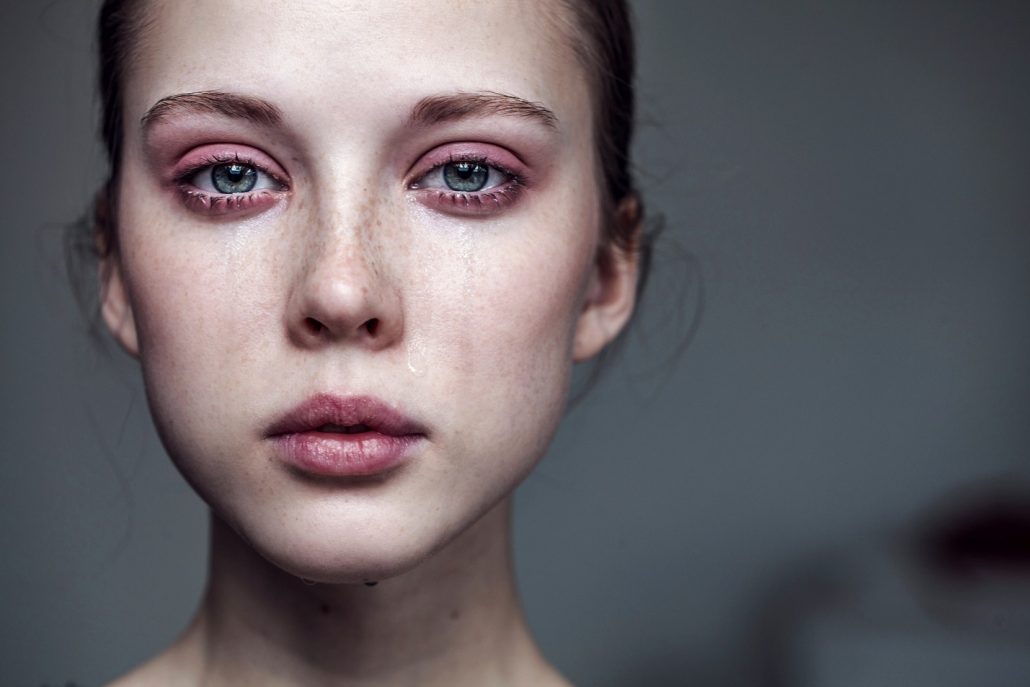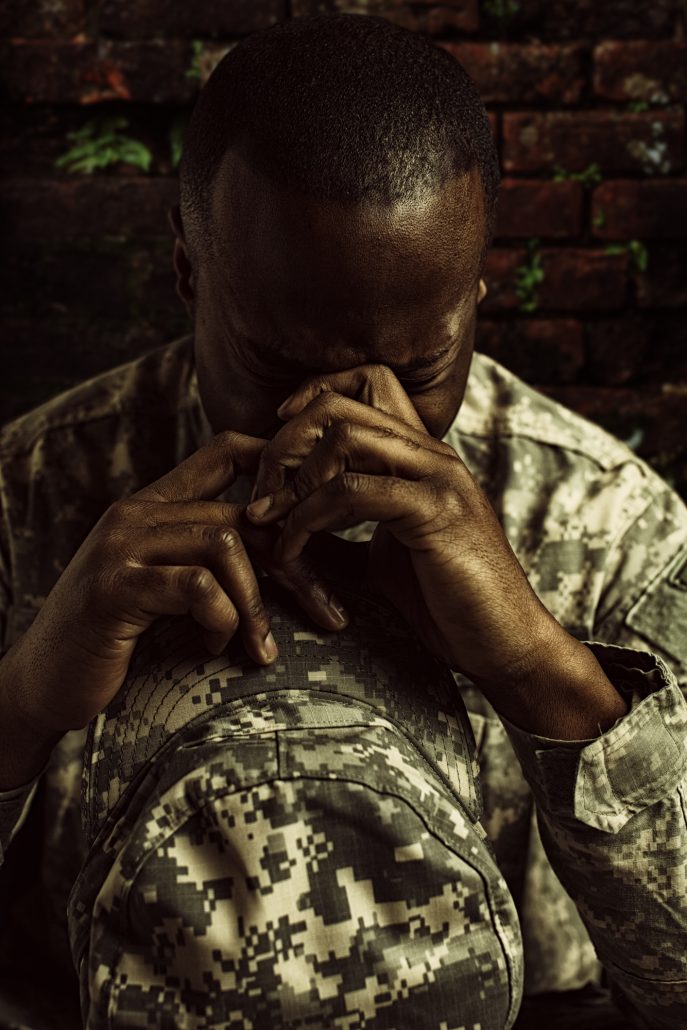by Justin Mckibben | Jun 5, 2018 | Addiction, Anxiety Disorder, Depression, Dual Diagnosis, Mental Health, Mood Disorders, Post-traumatic Stress Disorder, Recovery, Veterans, Violence

(This content is being used for illustrative purposes only; any person depicted in the content is a model)
In 2010, the United States Congress declared June 27th as PTSD Awareness Day. In 2014, the Senate designated the entire month of June as National PTSD Awareness Month. The purpose of this observation is to raise public awareness of PTSD and promote effective treatments to help those who suffer.
So what is PTSD? And how can all of us help?
Understanding PTSD
PTSD stands for Post-Traumatic Stress Disorder, which is a mental disorder that can develop when someone is exposed to a traumatic event. Some of the most common experiences that cause PTSD include:
- Warfare
- Sexual Assault
- Traffic collisions
- Life-threaten events
Sometimes people can experience post-traumtic stress disorder even if they are not directly affected by the event directly. According to the American Psychiatric Association:
- 5% of adults in the United States have PTSD in a given year
- 9% of people develop it at some point in their life
Signs and symptoms of post-traumatic stress disorder can include:
- Dreams, thoughts, or feelings related to traumatic events
- Mental or physical distress to trauma-related cues
- Attempts to avoid trauma-related cues
- Shifts in how a person thinks and feels
- Increase in the fight-or-flight response
Statistically, most people who experience a traumatic event will not develop PTSD. However, some people are more susceptible to certain forms of trauma.
Women and Post-Traumatic Stress Disorder
Women are more than twice as likely to develop PTSD.
- 10% of women experience PTSD in their lifetime
- 4% of men experience PTSD in their lifetime
This is largely attributed to sexual assault because women are more likely to experience sexual assault, and sexual assault is more likely to cause PTSD than many other events. Women are also more likely to experience things like:
- Neglect or abuse in childhood
- Domestic violence
- Sudden loss of a loved one
Sadly, women may be more likely to blame themselves for their traumatic experiences than men.
When it comes to how that trauma manifests, some symptoms are more common in women. For example, women are more likely to:
- Be jumpy
- Have trouble feeling emotions
- Avoid things that remind them of trauma
- Feel depressed and anxious
Men are more likely to have issues with anger and controlling it when dealing with PTSD, but both men and women struggling with post-traumatic stress disorder can develop physical health problems.
Veterans and Post-Traumatic Stress Disorder
Of course, one portion of the population at an elevated risk of PTSD is military Veterans. According to the RAND Center for Military Health Policy Research, 20% of Veterans who served in either Iraq or Afghanistan suffer from either major depression or post-traumatic stress disorder. Combat is one of the most traumatic situations a person can be in. Witnessing death and violence, while also being exposed to life-threatening situations can easily lead to PTSD.
However, something that most people may not realize is the amount of military sexual trauma (MST) that Veterans also experience. MST is a form of sexual harassment or assault that occurs while in the military, and it happens to both men and women during training, peacetime, and in war.
According to the U.S. Department of Veteran Affairs:
- 23% of women reported sexual assault while in the military
- 55% of women in the military experience sexual harassment
- 38% of men in the military experience sexual harassment
Because there are more male Veterans than female Veterans, over half of all Veterans with military sexual trauma are actually men.
Sadly, one of the most troubling statistics about mental health when it comes to the men and women who serve our country is that according to a SAMHSA study, only around 50% of Veterans who need mental health treatment will receive it.
Post-Traumatic Stress and Substance Use Disorders
Another heartbreaking side-effect of PTSD can be drug and alcohol abuse, which often leads to substance use disorder (SUD).
In some cases, people who experience a traumatic event that causes a physical injury will be treated with powerful painkillers. This is one way that prescription opioids have contributed to the current opioid crisis in the country. Prescription opioids often increase feelings of pleasure and calm inside the brain, which can lead to those struggling with PTSD abusing these medications in order to numb themselves to both their physical agony and their emotional trauma. In fact, prescription opioid addiction is most commonly found to correlate with PTSD.
When it comes to Veterans, developing a substance use disorder with post-traumatic stress disorder is not uncommon. According to studies from the National Institute on Drug Abuse (NIDA):
- 23% of Veterans returning from Iraq or Afghanistan showed signs of SUD.
- In 2008, active duty and Veteran military personnel abused prescription drugs more than twice the rate as the civilian population.
- In 2009, the VA estimated around 13,000 Iraq and Afghanistan Veterans suffered from alcohol dependence syndrome and required mental health treatment.
Meanwhile, those who experience sexual assault are also extremely likely to turn to drugs or alcohol as a means to cope with their trauma. According to a report by the American Journal on Addictions, 75% of women who enter addiction treatment programs report having experienced sexual abuse. Many studies over the years also report a prevalence of traumatic abuse in childhood.
Ultimately, we find that PTSD can feed into substance use disorder. Many people who struggle to control their emotions and suffer from the residual effects of their experiences try to self-medicate with both legal substances and illicit narcotics.
National PTSD Awareness Month: Call for Better Treatment
For National PTSD Awareness Month we can all do our part to help raise awareness of the impact of post-traumatic stress disorder. The National Center for PTSD is urging people to:
Learn- PTSD treatment works
Connect- Reach out to someone
Share- Spread the word
Online you can get educational materials, support information and resources to help spread awareness. The National PTSD Awareness campaign encourages everyone to work together to promote effective treatment for those who are suffering.
For those struggling with PTSD and substance use disorder, Palm Healthcare Company believes in providing innovative and life-changing treatment opportunities that help people struggling with trauma and addiction to overcome adversity and build a better quality of life. Our comprehensive programs use a holistic approach to help heal the whole person, and our facilities are specially designed to create lasting change. If you or someone you love is struggling, please call toll-free now. We want to help. You are not alone.
CALL NOW 1-888-922-5398
by Justin Mckibben | Apr 18, 2018 | Addiction, Anti-Social Personality Disorder, Anxiety Disorder, Depression, Dual Diagnosis, Mental Health, Mood Disorders, Post-traumatic Stress Disorder, Schizophrenia

(This content is being used for illustrative purposes only; any person depicted in the content is a model)
It is not so far-fetched to be told that someone whose life is consumed with drug or alcohol dependency can find themselves facing the emotional and mental fallout. When dealing with mental health issues, it is not rare for people to also struggle with substance use disorder. Co-occurring conditions such as these tend to feed off of each other, or even help create one another.
It is almost like when someone has high blood pressure, we are not surprised when they develop heart problems. Sometimes side effects and symptoms of one condition can nurture new ailments.
According to so researchers, there are some more common combinations of co-occurring disorders with addictions. So which addictions are most likely to co-exist with each mental health condition?
Here are 5 of the most common co-occurring disorders with addictions (not in any particular order):
-
Schizophrenia with Marijuana Addiction

One disorder that commonly co-exists with a substance use disorder is schizophrenia. The American Journal of Psychiatry released a study that suggests approximately half of all people with schizophrenia also have a substance abuse disorder.
But one substance stands out the most when looking at people living with schizophrenia- marijuana.
The exact cause of schizophrenia is unknown, but many suspect a combination of environment, genetics and altered brain chemistry and structure to all play a part. So it is unclear why people with schizophrenia would abuse marijuana. Especially since this drug typically produces many of the same symptoms these people experience when in the midst of a schizophrenic episode. Some of these symptoms include:
- Short-term memory problems
- Delusions
- Unusual or dysfunctional ways of thinking
- Difficulty beginning and sustaining activities
- Impaired executive functioning
While not all symptoms are the same for everyone, some of these more common symptoms definitely overlap between the two. While it may not be obvious why, research suggests it is pretty obvious that marijuana is most popular for people with schizophrenia.
-
Alcoholism and Anti-Social Personality Disorder

You might be surprised with this one because most people assume alcohol is most commonly matched with depression.
Anti-social personality disorder is easier to understand when one explains the concept of personality disorders in general.
To put it simply, a personality disorder is an enduring pattern of personal experience and behavior that deviates noticeably from the expectations of the individual’s culture, which leads to personal distress of impairment. So antisocial personality disorder (ASPD) is characterized by a tendency to disregard and even violate the rights of others. Symptoms can vary from egregious to outright dangerous. They include:
- Irritability
- Aggressiveness
- Lack of remorse
- Consistent irresponsibility
- Recklessness
- Impulsivity
- Deceitfulness
- Lack of stability in a job and home life
- Disregard for society and laws
- Violation of the physical or emotional rights of others
Often the more intense cases earn the titles of sociopathic or psychopathic.
Alcohol abuse very frequency co-occurs with other mental health disorders. However, according to the National Institute on Alcohol Abuse and Alcoholism (NIAAA), the disorder with the closest connection to alcoholism is anti-social personality disorder.
In fact, people who drink to excess on a regular basis are 21 times more likely to deal with ASPD when compared to people who don’t have alcoholism.
The NIAAA also states that both of these disorders typically develop early in life. However, alcoholism can actually make the underlying mental illness worse. Intoxication can lower an individual’s inhibitions, which makes their antisocial behaviors more prevalent. This may also lead to more dangerous manifestations of the disorder.
-
Anxiety Disorders and Cocaine Addiction

Cocaine is an extremely powerful narcotic stimulant, which gives users feelings of intense euphoria. However, the tradeoff is a very steep price to pay considering how dangerous this drug really is. Continued cocaine use typically leads to symptoms that essentially mirror an anxiety disorder, including:
- Restlessness
- Hallucinations
- Paranoia
- Insomnia
- Difficulty concentrating
- Aggression
Because cocaine is a stimulant, it speeds up and amplifies activity of the brain’s neurotransmitters. Certain neurotransmitters at higher levels induce anxiety. So anxiety is actually a symptom of cocaine use already. Cocaine use also has the potential to create psychotic episodes. Some people even experience severe mental symptoms as a result of use.
As a long-term effect of cocaine use, brain circuits are more sensitive while struggling to respond to natural stimuli, and the results are often related to mood and mental health. Statistics show that there is a very high risk of anxiety and cocaine abuse occurring together. Then if you already have an anxiety disorder, the risk becomes even higher that you will develop a severe emotional problem when using a drug like cocaine.
While the adverse effects of cocaine use can eventually fade for those able to achieve a long-lasting sobriety, sometimes the damage lingers. Those unusual thoughts and behaviors can continue even long after someone has given up the drug.
-
Prescription Opioid Addiction and PTSD

Post-traumatic stress disorder (PTSD) is a mental illness that takes hold in the aftermath of an intense and traumatic experience. Often, people who survive tragedies, war and other dangerous or life-altering events will experience PTSD.
In some circumstances, people will leave their experience with serious physical injuries, and often, those injuries are treated with prescription painkillers. This is just one way that prescription opioids have contributed to a huge epidemic that has been hurting America for the past several years.
Prescription opioids often boost feelings of pleasure and calm inside the brain, and sometimes people who have PTSD end up abusing these medications in order to experience euphoria and numb themselves to not just their physical agony, but also their emotional trauma. This can become an endless cycle of self-medicating. This is especially true with veterans. In fact, some research indicates that veterans with pain and PTSD are 3 times more likely to receive opioids compared to those without any mental health disorders.
It is true that having effective pain medications is very important to improve the quality of life for those with physical pain, especially chronic pain patients. However, mixing powerful opioids like prescription painkillers with PTSD can lead to tragic outcomes. With increasing rates of veteran suicides over the past several years, one can only image what impact the surging opioid crisis may have had on those struggling with PTSD.
-
Depression with Heroin Addiction

Throughout one of the worst drug epidemics in American history, heroin has been a driving force behind countless overdoses and skyrocketing death rates. Heroin isn’t just devastating physically, but also mentally and emotionally crippling. The connection between these adverse effects and depressive disorders is remarkable.
The allure of heroin is that is can make users feel an overwhelming sense of pleasure for a short time. However, long-time use of heroin can burn out the portions of the brain responsible for producing natural signals of pleasure, leaving them incapable of feeling good on their own without the drug. The drug alters brain chemistry and creates mood changes.
Advances in Psychiatric Treatment estimates that 48% of opioid users have experienced depression at some point in their lives.
Extended use of heroin can eventually cause a form of brain damage that leads to depression. Users can become physically incapable of feeling happiness unless the drug is present. Withdrawal symptoms from heroin can also exacerbate symptoms of depression. Many of them are actually overlapping symptoms, such as:
- Restlessness
- Irritability
- Slow thinking, speaking or body movements
- Loss of interests
- Sleep problems
- Physical pains
- Headaches
- Changes in appetite
The combination of depression and heroin addiction is incredibly common. Sometimes it can be difficult for people to tell which issue came first, but ultimately they can both be exceedingly debilitating, or even deadly.
Dual Diagnosis Treatment

Dual diagnosis means that a person is dealing with two medical conditions that are co-occurring. In regards to the field of drug addiction, dual diagnosis specifically means that someone is struggling with both substance use disorder and another mental or behavioral health issue. Sometimes it is because prolonged drug use has contributed to developing a mental health issue, while other times it is because someone has tried to self-medicate when facing a mental health issue.
Dual diagnosis treatment is so important because it provides the opportunity to treat both co-occurring disorders simultaneously. For those suffering with more than one disorder, it is not nearly as effective to focus on treating one while ignoring the other. Holistic healing is all about addressing every aspect of each individual to help them find success in every part of their life.
Palm Healthcare Company believes in providing holistic addiction resources to help treat not just the addiction, but also any other issue that could be holding you back from achieving a full life of lasting recovery. If you or someone you love is struggling, please call toll-free now.
CALL NOW 1-888-922-5398
by Justin Mckibben | Oct 13, 2017 | Depression, Dual Diagnosis, Mental Health, Mental Health Stigma, Panic Disorder, Post-traumatic Stress Disorder, Recovery, Suicide, Therapy, Veterans

(This content is being used for illustrative purposes only; any person depicted in the content is a model)
When we talk about fighting the addiction problem in America and better understanding substance use disorder, we have to acknowledge those who are at a specific risk for suffering from substance use. Far too many American soldiers come home only to fight another devastating, heartbreaking battle.
With addiction being considered a mental health issue, it should be clear the contribution of overall mental health makes to causing substance use disorder (SUD) in many cases. Depression, bipolar disorder, generalized anxiety disorders and post-traumatic stress disorder (PTSD) are all mental health issues that often associated with addiction.
Some of those susceptible to mental health disorders and substance abuse are those who fight for the safety and freedom of our country; our Veterans. So we need to acknowledge the mental health issues that the men and women who sacrifice everything for this nation are suffering through. We need to talk about how to best understand these conditions, and how to best treat those in need.
Veteran Mental Health Disorder Statistics
According to the RAND Center for Military Health Policy Research:
-
20% of Veterans who served in either Iraq or Afghanistan suffer from either major depression or PTSD
-
5% of Veterans in these two categories have suffered a traumatic brain injury
According to the U.S. Department of Federal Affairs:
-
More than 2 out of 10 veterans with PTSD also suffer from SUD
-
In the wars in Iraq and Afghanistan, about 1 in 10 returning soldiers seen in VA have a problem with alcohol or other drugs.
-
Almost 1 out of every 3 Veterans seeking treatment for SUD also has PTSD.
-
War Veterans with PTSD and alcohol problems tend to be binge drinkers.
-
Among all U.S. adult deaths from suicide, 18% (7,403) were identified as Veterans of U.S. military service
Probably one of the most troubling statistics comes from a study by the Substance Abuse and Mental Health Services Administration (SAMHSA) which tragically revealed:
Only 50% of returning vets who need veteran mental health treatment will receive these services.
That is an extremely troubling number. It says a lot about how Veterans are struggling to get the help they need when you realize that only around half of them ever get it.
Veterans and Substance Abuse
One of the hardest issues to address when examining the veteran mental health issue is substance abuse and SUD. It is also one of the most important aspects of Veteran mental health treatment that need to be acknowledged.
The National Institute on Drug Abuse (NIDA) reports that substance abuse among veterans is strongly connected to their experiences in combat and how they struggle to cope with these traumas. Various NIDA studies indicate that:
-
25% of Veterans returning from Iraq and Afghanistan showed signs of SUD
-
In 2008, active duty and veteran military personnel abused prescription drugs at a rate that was more than twice the rate for the civilian population
-
In 2009, the VA estimated that around 13,000 vets from Iraq and Afghanistan suffer from alcohol dependence syndrome and require veteran mental health treatment for this problem.
PTSD and SUD
A lot of people, even those who are not Veterans but have experienced great trauma, use substances to self-medicate and deal with PTSD. Even for those who have never had an issue with substances or may never have even used substances, PTSD increases the risk an individual can develop a drinking or drug problem or SUD.
To make matters worse, PTSD and SUD can likely lead to other problems in life, including health. These Veteran mental health issues can often be associated with:
Ultimately, using drugs or alcohol in combination with PTSD might seem to make things easier, but will actually make them a lot worse. It creates a vicious cycle of numbing and re-traumatizing.
Better Treatment for Veteran Mental Health and Addiction
Many advocates for Veteran services, including the National Veterans Foundation (NVF), believe:
- More funding needs to be allocated for Veteran mental health care services so that every veteran has easy access to this type of care.
- Excessive wait times at local VA facilities need to be addressed in order to grant people the access they need to these services.
The NVF website states:
“We can no longer look the other way or continue to underfund the mental health care system that our veterans use.”
This should absolutely be a priority. Strengthening the system that provides mental health care not just to citizens who are suffering, but to our vets who have given so much and desperately need help, is crucial to saving lives from substance use disorder.
Not only does Palm Healthcare Company understand the importance of providing quality addiction recovery treatment, but we also know how important dual diagnosis treatment is for those who suffer from serious mental health conditions like PTSD or major depression along with addiction. Better treatment means addressing both conditions simultaneously, to help the individual heal holistically.
Palm Healthcare Company also knows how important it is to help those first responders and Veterans that put their lives on the line every day. That is why we are a proud sponsor of the Harrigan Foundation’s Annual Run to the Rescue 5K to raise money for the treatment of first responders and veterans.
To find out more about this event, visit the link here:
Harrigan Foundation’s Annual RUN TO THE RESCUE 5K
Mental health care and addiction treatment for vets is an important resource that can save lives and our veterans put their lives back together after experiencing trauma and hardship that causes PTSD and the devastation of substance abuse. If you or a loved one is struggling, you don’t have to fight alone. Please call toll-free now.
CALL NOW 1-888-922-5398
by Justin Mckibben | Oct 5, 2017 | Coping Skills, Death, Drug Abuse, Dual Diagnosis, Mental Health, Panic Disorder, Post-traumatic Stress Disorder

Just this past Sunday the nation saw one of the deadliest shootings in modern American history in Las Vegas. This immense and indescribable tragedy shocked the world as news reports and live footage filled the airwaves after a gunman opened fire with high-powered rifles at an outdoor music festival. At this point there are at least 58 dead and over 520 wounded, making it the deadliest mass shooting in recent history.
The heartbreak and weight of this tragedy truly cannot be put into words. The unimaginable loss is without parallel. Beyond those who lost their lives in such a senseless act of violence, the impacts this event has had on countless friends, families and loved ones are unfathomable.
In the aftermath of the Las Vegas shooting, mental health must be a priority. How we address and protect the psychological well-being of every American must be a very serious part of the conversation. We have to take a close look at how we are facing mental health, and support those who have been traumatized in the wake of such horrific events.
PTSD of Mass Shootings
The risks of post-traumatic stress disorder (PTSD) is extremely elevated in situations like this. Research on mass shootings is not extensive but is sufficient enough to allow for some preliminary conclusions. One study examined 15 mass shooting events to review consequences of the incidents upon survivors. From these studies conclusion, researchers stated:
- Prevalence of post-disaster diagnoses (predominantly PTSD) in these studies ranged from 10% to 36%
- Much higher percentages reported sub-threshold PTSD
- Very few participants reported no symptoms
One 1994 study in the American Journal of Psychiatry shows that in the acute post-disaster period:
- 20% of the men met criteria for PTSD after a mass shooting
- 36% of the women met criteria for PTSD
The same study looked at those with post-disaster PTSD who also met criteria for another post-disaster psychiatric diagnosis, especially major depression. They found:
- One-half of the women met the criteria
- One-fourth of the men met the criteria
Experts say most people will recover fully from post-disaster PTSD within 6 to 16 months, but most still emphasize the importance of support.
Not only can those present at the tragedy be affected directly, but also those not present but connected to the location or individuals present can be affected vicariously. You don’t have to experience something so horrifying first-hand to suffer a severe impact. An attack like this can have deep emotional effects on those who witness the event, or even for those all over the world following the story.
Understanding PTSD
Part of dealing with the residual effects of tragic events and disasters is to understand how conditions like PTSD can impact people. PTSD can result in emotional, physical and even cognitive issues that some people may not know how to recognize or cope with.
Emotional Effects of PTSD Include
- Shock
- Terror
- Irritability
- Blame
- Anger
- Guilt
- Grief or sadness
- Emotional numbing
- Helplessness
- Loss of pleasure derived from familiar activities
- Difficulty feeling happy
- Difficulty experiencing loving feelings
Physical Effects of PTSD Include
- Headaches
- Fatigue
- Exhaustion
- Insomnia
- Startle response
- Cardiovascular strain
- Increased physical pain
- Reduced immune response
- Gastrointestinal upset
- Decreased appetite
- Decreased libido
Cognitive Effects of PTSD Include
- Decreased concentration
- Confusion
- Impaired decision making
- Disbelief
- Dissociation
- Nightmares
- Impaired Memory
- Decreased self-esteem
- Reduced self-efficacy
- Self-blame
- Intrusive thoughts/memories
- Anxiety
All of these things can cause other more personal issues. Some will experience difficulty with intimacy or social relationships. Isolation and alienation can develop at work, at school or even at home.
According to PTSD United, a nonprofit organization dedicated to providing support and resources for those suffering from PTSD:
- 70% of adults (approximately 223.4 million people) in the US have experienced some type of traumatic event at least once in their lives.
- Up to 20% of these people go on to develop PTSD.
- Approximately 44.7 million people today either have struggled or are struggling with PTSD.
With PTSD, a lot of people actually turn to drugs or alcohol to self-medicate. Some will rely on substances as a form of relief when PTSD brings feelings of isolation or depression. However, as people try to numb or distract themselves from these feelings, they tend to create more problems through substance use.
Often times, the substances only fuel feelings of isolation, depression or anxiety.
Make Mental Health a Priority
This week, October 1 through October 7, is Mental Illness Awareness Week. There is no time like the present to discuss the current state of mental health across the country. Now is always the time to advocate for better support, services, and acceptance when discussing mental illness and mental health in America.
According to the National Institute of Mental Health (NIMH):
- 9% of all U.S. adults (43.4 million)qualified as having mental health issues in 2015
- Approximately 20-21% of incarcerated Americans have a “recent history” of mental health issues
- 70% of young people caught up in the juvenile justice system have at least one mental health issue
- 46% of people living in homeless shelters live with severe mental health issues and/or substance use disorders (SUDs)
In the aftermath of such profound tragedy like the recent shooting in Las Vegas, or even natural disasters like recently with Hurricane Irma or Hurricane Maria, there should be a very direct conversation about mental health. We should also work diligently to ensure that while the world grapples with opioid addiction and drug abuse, that more people don’t turn to self-medicating to fight feelings of loss, terror or alienation.
For all survivors of recent tragedies, or those affected indirectly, there are ways to take care of yourself and monitor your own mental state. Make your own mental health a priority. Protect yourself from destructive behaviors, and reach out for help in the wake of such emotionally compromising events as what happened in Las Vegas.
The national crisis hotline also offers confidential and free services 24/7/365 Call (775) 784-8090 or text ANSWER to 839-863
Our hearts and prayers go out to all those touched by this tragedy.
If you or someone you love is struggling with trauma, don’t let substance abuse make it all even worse. Drugs or alcohol are not the answer. There is real help out there. Please call toll-free now.
CALL NOW 1-888-922-5398











